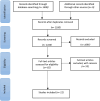The impact of food and nonalcoholic beverage sponsorship and marketing in the school environment on the food choices of school-going children and adolescents: A scoping review, 2011-2023
- PMID: 40156044
- PMCID: PMC12246883
- DOI: 10.1111/obr.13923
The impact of food and nonalcoholic beverage sponsorship and marketing in the school environment on the food choices of school-going children and adolescents: A scoping review, 2011-2023
Abstract
Globally, childhood obesity presents as a major public health challenge that is steadily on the increase. This is a result of, among other factors, children consuming excessive amounts of empty calories, specifically from foods high in saturated fats, refined sugar, and sodium, which may be exacerbated by targeted marketing and sponsorships. This scoping review aimed to investigate the prevalence of food and nonalcoholic beverage marketing in schools and to determine the impact marketing and sponsorship in the school environment has on the food choices of school-going children and adolescents. The objectives of the scoping review were to conduct a systematic search of available and relevant literature, identify recurring themes and knowledge gaps, and make recommendations for future research. For this scoping review, PubMed, Scopus, Web of Science, and EBSCO were searched for relevant studies published between 2011 and 2023. Gray literature was searched for on ProQuest and Google Scholar. The results were exported from the database into CADIMA for screening and data analysis; 1608 references were screened. Twelve primary studies (n = 12) were included in the final review. The evidence mapped out through this scoping review found that a link has been established between food and nonalcoholic beverage marketing and enhanced interest in these products from adolescents. It showed that food and nonalcoholic beverage marketing is prevalent in the school environment and influences the dietary behavior of school-going children. The school food environment is an opportunity to positively influence children and adolescents' food choices and consumption habits through nutrition education and health promotion.
Keywords: adolescents; food choices; food marketing; school environment.
© 2025 The Author(s). Obesity Reviews published by John Wiley & Sons Ltd on behalf of World Obesity Federation.
Conflict of interest statement
The authors declare no conflict of interest.
Figures
References
-
- Abarca‐Gómez L, Abdeen ZA, Hamid ZA, et al. Worldwide trends in body‐mass index, underweight, overweight, and obesity from 1975 to 2016: a pooled analysis of 2416 population‐based measurement studies in 128·9 million children, adolescents, and adults. Lancet. 2017;390(10113):2627‐2642. doi: 10.1016/S0140-6736(17)32129-3 - DOI - PMC - PubMed
-
- Mis NF, Braegger C, Bronsky J, et al. Sugar in infants, children and adolescents: a position paper of the European society for paediatric gastroenterology, hepatology and nutrition committee on nutrition. J Pediatr Gastroenterol Nutr. 2017;65(6):681‐696. doi: 10.1097/mpg.0000000000001733 - DOI - PubMed
Publication types
MeSH terms
LinkOut - more resources
Full Text Sources
Medical


